Session 9 - Security & User Authentication
Most information websites allow anonymous access to browse their content. However,
eCommerce and service oriented web sites tend to have pages which should only be
accessible to certain users. For example, Administrators may need to use web based
access to perform maintenance tasks on a site, or information providers may want
to restrict full access to a site to those users who have subscribed to the service.
Also, different classes of user, e.g. Anonymous, Member and Admin roles may be given
access to the site in different ways.
ASP.NET v2.0 provides a comprehensive, built-in mechanism for user authentication
and role management, coupled with user profiling which allows the server to store
and act on information about each user's activities on the website. For example,
a user may customise their user interface by choosing a different theme. This can
be saved in the user's profile so that when they visit the site again they will
pick up again with the same theme.
User management, maintenance and profiling can be done within an application, but
initial security settings are controlled though a Web application administrative
website. The administrative website can not only configure security settings but
also manage user accounts and roles. This makes it easy for the application developer
to setup test user accounts, system accounts and default settings for the site.
VWD also provides a set of controls for building login forms, registration forms
and user management forms into an application. The controls are context sensitive
so that alternative content can be displayed depending on the role of the user.
For example, an anonymous user would get a login form and a link to a registration
form on the pages they see, but once logged in the user interface would remove those
features and display their login status together with a new set of links in the
menu. Administrative users would get further menu choices once logged in. The menu
system is adapted to the user by using the Roles attribute for each page in the
sitemap.
User based management and control is performed using an underlying database containing
user information, password and role information. This database is created automatically
by VWD through the Website administration site.
Overview of the process
Before we look at configuring security and producing user interface elements in
detail we will take an overview of the processes. Initial configuration of the security
aspects are done independent of your web page design. The following steps are required:
- Create folders in your web application for use by different types of user.
-
Run the Web Site Administration Tool and configure it to use a security database.
-
Enable forms (Internet) authentication
- Create some test users.
- Create
the roles associated with different type of user.
- Set access rules for each
role to the different folders.
- Modify the application configuration file to
enable security-trimming of menus.
Once you have security setup you can build in membership and login functions into
your web pages.
- Modify the sitemap for your website to include role information. This will allow
the system to trim menus when the user does not have permission to access some of
the pages in the site.
- Include a LoginView control on your pages to allow
you to display different information for anonymous and logged in users.
- Include
a Login control on the anonymous pages so that a user has the opportunity to login.
-
Include a login status control on pages which need to display information about
the logged in user.
- Create a registration page so that users can register
to use the website.
- Create a user admin page so that users can administer
their own account.
Step by step
The starting point for this exercise will be a three page site with the following
structure:
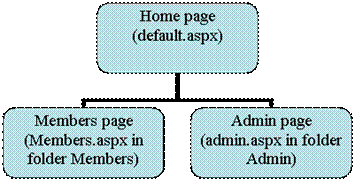
- Create a new C# ASP.NET website called SecureNavigate.
- In the Solution
Explorer create two new folders called Members and Admin.
- In the Members folder
add a new item of type web form called Members.aspx.
- In the Admin folder add
a new item of type web form called Admin.aspx.
- Add a sitemap file and edit
the text to look like this:
<?xml version="1.0" encoding="utf-8" ?>
<siteMap xmlns: ... >
<siteMapNode url="~/default.aspx" title="Home page" >
<siteMapNode url="~/admin/admin.aspx"
title="Admin page" />
<siteMapNode url="~/members/members.aspx"
title="Members page" />
</siteMapNode>
</siteMap>
Your solution explorer window should look like this:

- Open default.aspx and add a Menu control. The Common Menu Tasks taskbar should
pop up next to the Menu control as follows:
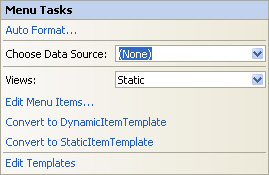
- Select New Data source from the Choose Data Source dropdown.
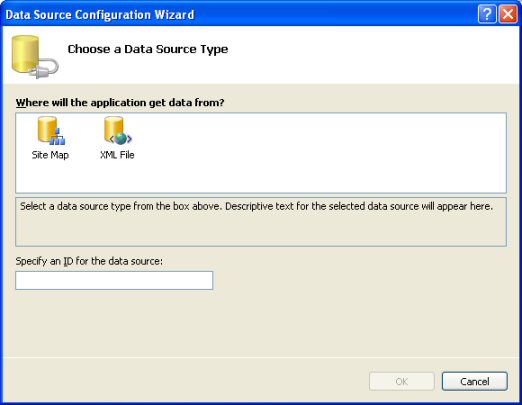
- Choose Site Map and click OK
- Add a heading to the page to indicate that it is the home page.
- Repeat the process for the Members.aspx and Admin.aspx pages, and make the headings
on each page distinct so that users know which page they are on.
- Run the project and you should be able to navigate to the three pages.
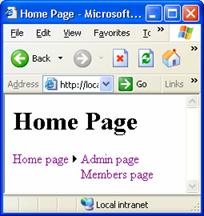
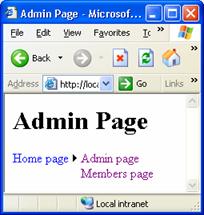
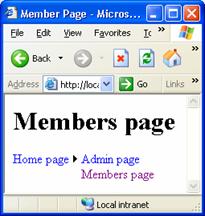
- From the menu choose Website | ASP.NET Configuration.
- This launches a
web based wizard for configuring security and membership.
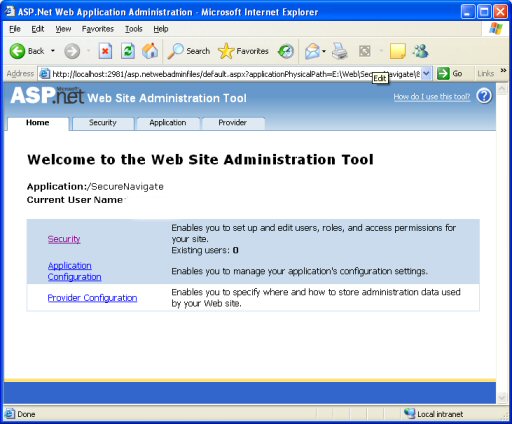
- The first
task is to test the database for holding the information. Click the 'Provider'
tab.
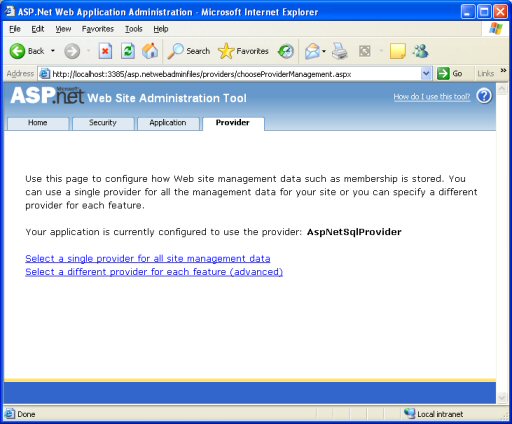
-
Choose 'Select a single provider for all site management data'.
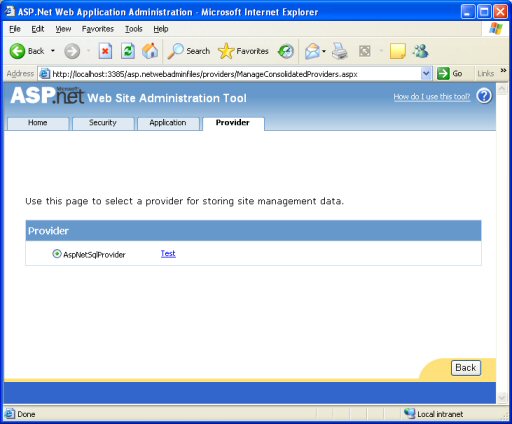
-
Press the 'Test' link next to AspNetSqlProvider . You should get a success message.
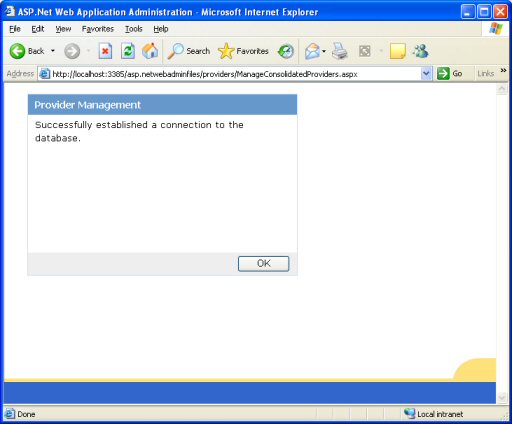
- Press
OK, to return to the previous screen then click the 'Security' tab.
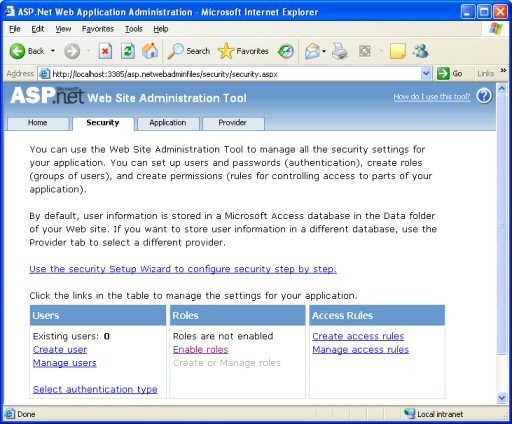
The next stage is to set security, by setting the authentication model for the application
and creating users, roles and access rights.
- Click 'Select authentication type'.
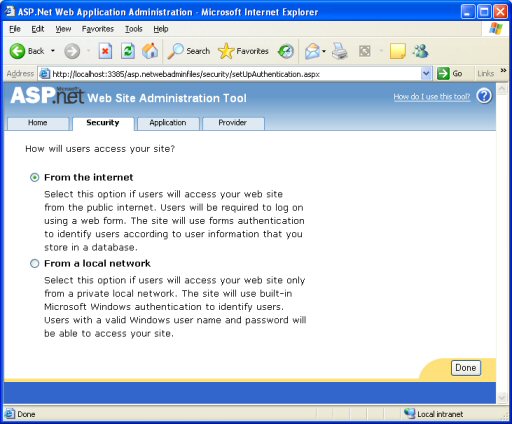
- Choose 'From the Internet' and click done.

-
It is now possible to create Users. Before we do that
we will enable Roles by selecting Enable roles.

-
Press Create roles.
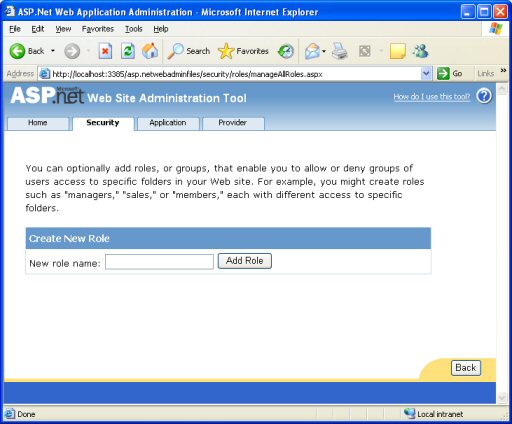
- Type Admin for the New role name and click Add Role.
- Type Member for
the New role name and click Add Role.
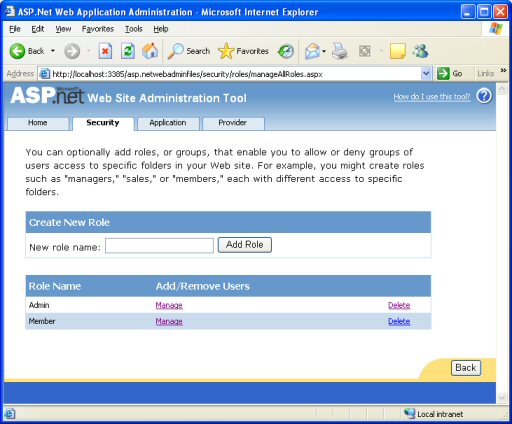
- Click
Back and click Create User
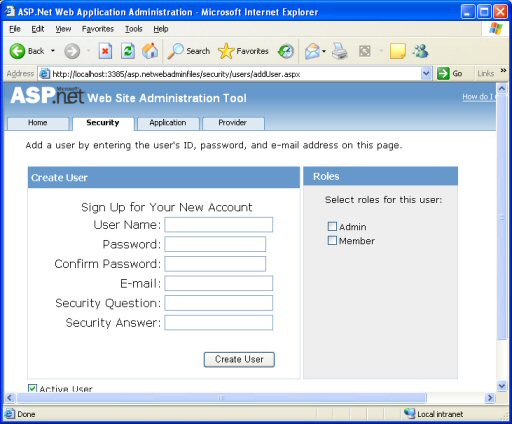
-
We need to add two test users. One can be called adminuser and the other can be
called memberuser. Use P@ssword for the password, the security question
and security answer. Type in a dummy email address such as [email protected] and [email protected] for the
users. Make sure you select the admin role for adminuser before pressing Create
User, and press Continue to allow you to create another user. Make sure you select
the member role for memberuser before pressing Create User. Now click Back. Note
that if you make a mistake when creating users it is awkward
to go back and change them you will need to delete the user and
go through the process again.
You should now see that you have 2 users defined and 2 roles defined. We now need
to associate each role with permissions to use the different bits of the site. A
user with role admin will be able to access all areas of the site. A user with role
member will be able to access the home folder and the members folder.
-
From the Security page click Create access rules.
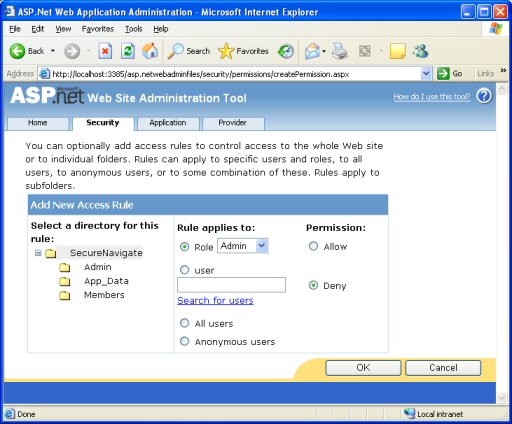
- Adding roles is tricky, so make sure to select all options
in turn. (The web interface does not show the current information clearly.) Select
the SecureNavigate directory (this is the home directory).
Select 'All users' and select 'Allow'. Click OK.
- Select Create access rules. Select the Admin directory, select
Role 'Admin'
and select 'Allow'. Click OK.
-
Select Create access rules. Select the Admin directory, select 'All users' and
select 'Deny'. Click OK.
-
Select Create access rules. Select the Members directory, select
Role 'Admin'
and select 'Allow'. Click OK.
- Select Create access rules. Select the Members directory, select Role 'Member'
and select 'Allow'. Click OK.
- Select Create access rules. Select the Members directory,
select 'All users' and
select 'Deny'. Click OK.
- Close the ASP.NET Configuration
web page.
Security has been set now on the pages. If you run the application you will be able
to browse to the home page, but if you try to browse to the admin page or the members
page you will see an HTTP Error 404 page (The resource cannot be found).

This is because the system knows that to be able to access the admin and member
pages the appropriate user needs to be logged in. The system will by default attempt
to call a page called login.aspx, to attempt to authorise the user. All we need
to do is provide a new web form called login.aspx with a Login control on it.
-
In Solution Explore right click on the application
and choose Add New Item ...
-
Choose Web form and name it login.aspx
-
Put a suitable heading at the top of the form,
and then drop a Login control onto the form.
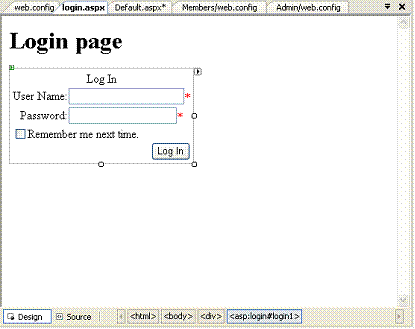
-
Save the page, switch to default.aspx and run the application.
If you try to access the admin page or the members page a login form will appear.
This will happen even if you try to access the pages directly by typing in the URL.
The next stage is to set the menu system so that it does not offer pages which are
not accessible. This is called menu trimming. We will also need a Login control
on the home page (and maybe other pages) to allow people to login and see the full
set of menu options for their role. We will add a login form on the home page first.
Menu Trimming
Menu trimming cannot be done from the VWD user interface. It requires some settings
to be changed in the Web.Config file for the application. Web.Config is an XML file
which lists all the configuration information for pages in an application folder.
Your application should have three Web.Config files; one in the home directory and
one in each of the admin and members directories. The files in the admin and members
directories have configuration information for access rules. For example, the Admin
directory Web.Config looks like this:
<?xml version="1.0" encoding="utf-8"?>
<configuration>
<system.web>
<authorization>
<allow roles="Admin" />
<deny users="*" />
</authorization>
</system.web>
</configuration>
As you can see it contains an authorization section where only role 'Admin' is allowed
access and all other users ('*') are denied access.
The Web.Config file for the application home folder is more complex. It contains
configuration information for the whole application, including database connections,
authorisation and membership information etc. We need to add a new configuration
section for the sitemap by providing a named connection to the sitemap (MyXMLSiteMapProvider)
and configuring it to trim menus based on security information (securityTrimmingEnabled).
This also needs to be linked to the menus on each page.
The XML for the sitemap configuration looks like this.
<siteMap defaultProvider="MyXmlSiteMapProvider" enabled="true">
<providers>
<add name="MyXmlSiteMapProvider"
type="System.Web.XmlSiteMapProvider, System.Web,
Version=2.0.3600.0, Culture=neutral,
PublicKeyToken=b03f5f7f11d50a3a"
securityTrimmingEnabled="true"
siteMapFile="Web.sitemap"/>
</providers>
</siteMap>
- Open default.aspx and drag a Login control onto the page.
- Open the Web.Config
file in the home directory and find the start of the system.web
section (<system.web>).
- Copy the XML for
the siteMap section from above into the XML file, immediately after the <system.web>
line.
- Open each of
your web pages, select the SiteMapDataSource control and set the SiteMapProvider
property to MyXMLSiteMapProvider.
We now have a system which uses security information to trim the menus based on
the login status of the user. The user can login from the home page and therefore
access the appropriate sections without having to know the URLs directly. Download
a
ZIP version of SecureNavigate.
Notes
The above processes may seem complex, however, if you take advantage of Master pages
to build the user interface for your pages you only need to set up the properties
once. The menus and login forms are built into the master page.
A property of the Login control is VisibleWhenLoggedIn. If you have this property
set to 'false' for the login form on the home page the user will not see the login
form once they have logged in.
More login based controls
The Login control we used in the previous section provides a one way access mechanism.
I.e. it allows you to login, but it does not allow you to logout. We also sometimes
want to modify our user interface based on the type of user which is currently logged
in. The previous section allows us to modify the set of web pages we can see from
a menu, but sometimes we may want a web page to be accessible to everyone, but to
display different information for different users. We may also want to provide a
mechanism for users to register themselves and to be able to manage their own accounts
(e.g. change a password).
The Login section of the toolbox, contains a set of controls which give you this
flexibility. The following sections will describe each control with simple examples
of their use.
LoginStatus
The LoginStatus control has two views (and LoggedOut view and a LoggedIn view).
If there is no user logged in the default is for the LoginStatus control to show
a
Login link. When logged in the control displays a Logout link. The default behaviour
of the Login link is to call the login page (login.aspx). This control therefore
provides a simple mechanism to control users logging in and out, and so there is
no need to have a login form on any page other than login.aspx.
CreateUserWizard
This control provides the user interface to allow a user to register themselves
on the user database. The user will by default be active, but have no roles allocated.
By default the user will be logged in when their account is created, but there is
a property to disable this. You can use the CreatedUser event to add code to allocate
roles to the user once their account is created. E.g. the code to add a user to
the 'Members' role and to disable their account is:
void CreateUserWizard1_CreatedUser
(object sender, EventArgs e)
{
MembershipUser User;
User = Membership.GetUser(CreateUserWizard1.UserName);
User.IsApproved = false; // change to true for automatic approval
Roles.AddUserToRole(User.UserName, "Member");
Membership.UpdateUser(User);
}
LoginName
We sometimes want to include the account name of the logged in user on the web page.
The LoginName control allows just that. If a user is not logged in the control displays
nothing.
ChangePassword
This control displays a form which allows the user to change their password. The
user must provide their old password and type the new password twice.
PasswordRecovery
This control displays a wizard form which allows the user to request their password
be emailed to them. The user must submit their email address, and answer their security
question.
LoginView
This control provides the most flexibility. It acts as a set of containers for other
controls and web content. There are by default two container; one for anonymous
users and one for logged in users. If you put different controls into the two containers
the page will change depending on whether the user is logged in or not. For example,
you could put a simple text message in the Anonymous container which reads 'Please
log in', and you could put a message 'Logged in user: ' and a LoginName control
in the LoggedIn container.
However, the flexibility of the LoginView control does not end there. You can add
containers to the LoginView control based on Role Groups. The Smart Tag dialog allows
you to edit role groups. You define lists of roles which you want to have the same
content. E.g. in our application from the preceding section we would have one role
group containing just the role 'Admin' and another role group containing just the
role 'Member'. This would give us two more containers for web content. Once we have
role groups added we can edit the content by dragging controls and typing into the
container. When the application is running, logged in users who aren't in a role
group would get the LoggedIn container, and anonymous users would still get the
Anonymous container.
Using this control you can create customised content based on the status of the
user without having to write any code.
Session 9 - Workshop
- Try to reproduce the security aspects from the above example in the site you created
from Session 8.